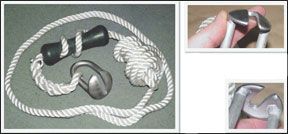Using an elastic nylon riding stopper (aka snubber) is always recommended when deploying an all-chain rode. Snubbers act as shock absorbers between rode and vessel, while at the same time transferring surge loading caused by wind and waves from the windlass to a deck cleat. No windlass is built to bear the load of a deployed anchor, particularly the bone-jarring snatches of an all-chain rode fetching up short.

Snubbers are typically constructed from three-strand nylon, which provides more stretch than double-braided line. Theyre installed between the boats mooring attachment point and chain forward of the bow roller, so that a loop of chain hangs down while the snubber takes the load. The preferred method of attaching a snubber to a chain is via a specialized hook, called a “devils claw,” although a rolling or camel hitch can also serve well. The problem with the hitches is that they can be hard to untie if you need to lay out more rode in a storm.
There are many variations of devils claws available, including one from Quickline USA, the Ultra Chain Grab and Snubber.
The one we inspected (No. 8 unit) comprises an Ultra Chain Grab Size 8 (for 1/4- or 5/16-inch chain), about 12 feet of 1/2-inch nylon rope, and a No. 3 rubber snubber (for additional shock absorbing).
Constructed of welded, 316L stainless steel, the Ultra Grab is easily attached or removed from a taut chain rode. The hanging loop of chain is important as its weight helps keep the unit in place as the anchor rode catenary flattens (due to increased loads from wind or current). Once you begin weighing anchor and the load is removed from the snubber, the chain grab automatically releases to prevent the unit from getting caught in the windlass upon retrieval, a nice feature.
You can also add line to the Quickline grabber using a bowline to create a mooring bridle, which gives you additional flexibility, such as the ability to angle your vessel into the wind or swells by adjusting the lengths of each leg.
The chain grab we have (for both 1/4-inch and 5/16-inch chain) has an advertised breaking load of 5,390 pounds. Its roughly 2,200 pounds shy of the 7,600-pound breaking load of 5/16-inch chain, however an Internet scan showed its rated breaking load meets or exceeds that of any other unit found.
Once the snubber is attached, you let out enough chain to position the grab or claw roughly half the distance between the anchor roller and the water. While the 12 feet of line provided with our test unit may be adequate in most cases, once the line is secured around a cleat, it is too short, in our opinion. Fifteen to 25 feet would provide additional length and load-absorbing stretch.
Prices for the Ultra Chain Grab and Snubber range from $141 (size 6 for 3/16-inch chain) to $522 for the size 20 (for 3/4-inch chain). The Ultra Chain Grab and Rubber Snubber can be purchased separately and are available in six sizes. The chain grab and snubber system were testing retails for $178. The No. 8 Ultra Chain Grab can be purchased separately for $86, a price competitive with units from other manufacturers. The Size 3 rubber snubber sells for $43, for a total of $129. As 1/2-inch, three-strand nylon rope runs around a buck a foot, you could actually save around $35 by making up your own. However if your splicing is in doubt, you may want to spend the extra $49 for an assembled system.

































